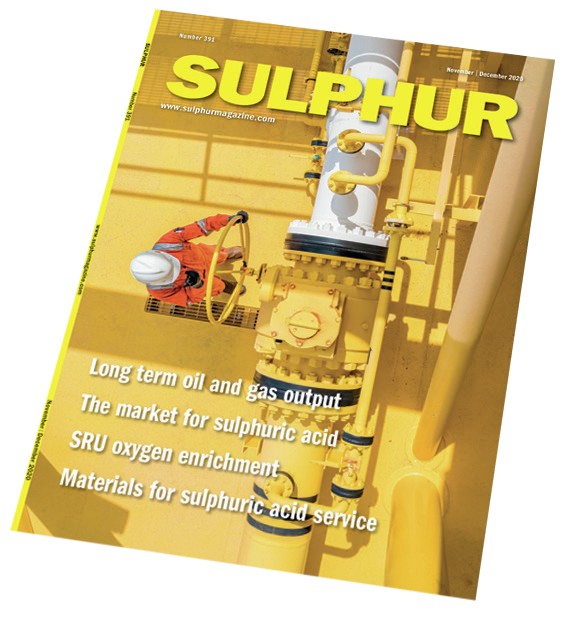Sulphur 391 Nov-Dec 2020

30 November 2020
Can you spare a nickel?

“The technical challenges of HPAL have not gone away”
Metal markets are used to ups and downs, and, as we discuss elsewhere in this issue, this year has seen more than most, mainly thanks to the virus that is still keeping us indoors – as I write this, the UK has just moved back into a second national ‘lockdown’. However, this year has seen the fortunes of one metal in particular simply rise and rise – nickel.
Nickel made a big splash in the sulphuric acid industry during the 90s and 00s as China’s demand for stainless steel began to skyrocket, and deposits of nickel sulphide ore started to become scarce, leading to attempts to exploit lower grade laterite deposits. Laterites are oxidised ores, and harder to extract nickel from, and so numerous producers tried using acid at high pressures and temperatures in the high pressure acid leach (HPAL) process. Around 5 million t/a of acid demand came from new HPAL plants over the period 2010-2015. However, handling acid under such conditions proved technically very challenging, as well as expensive, which became a problem when rival processes began to undercut it. The problem is, if you only need the nickel for stainless steel, then you don’t need to separate the iron from the ore, and can get away with cheaper thermal processes, producing ferronickel or even ‘nickel pig iron’ (NPI). NPI became all the rage in China, and then, when Indonesia started to try and capture more of the value chain by restricting ore exports, in Indonesia too. Couple that with the slowdown in the Chinese economy, and things became very difficult for HPAL producers.
Now, however, the need is not for nickel per se, but for nickel sulphate, and at very high purity levels. The reason, of course, is the burgeoning electric vehicle (EV) market, which needs nickel sulphate for its batteries. Suddenly, high purity nickel is very scarce. Elon Musk, the world’s fifth richest man, has taken to public forums this year to literally beg companies to mine more of the stuff for his Tesla car company, and has entered talks with Vale, BHP and the Indonesian government. As a result, demand for nickel – currently just over 2 million t/a – is forecast to increase rapidly this decade. Some projections suggest demand for nickel could more than double by 2040. There are shortages projected as soon as 2023 due to a lack of new projects in the pipeline. On October 16th, Glencore’s CEO Ivan Glasenberg said that his company intends on “running down its coal mines” to reduce carbon emissions, and that it will use the funds freed up to invest instead in minerals such as copper, cobalt and especially nickel for energy transition markets and electric vehicles.
The upshot is that nickel projects, particularly HPAL-based, are all the rage again. This year First Quantum has re-started its Ravensthorpe HPAL plant in Australia, which it had bought off BHP when the latter decided to get out of HPAL, but which it too had not been able to operate profitably and closed down in 2017. Indonesia now has no fewer than six HPAL projects on the go, some backed by major Chinese investors like Tsingshan and Ningbo Lygend. Indonesian demand for acid for nickel production could reach 3 million t/a over the next few years. There are also expansions in the Philippines and Australia, and even Brazil.
But the technical challenges of HPAL have not gone away, as Vale could tell you. Its Goro nickel HPAL project on New Caledonia has been a problem child for the company, starting two years late in 2010, suffering a number of operational issues and incurring a $1.6 billion write-down. This year it is expected to produce at only 40% of its notional capacity, an attempted sale to Australia’s New Century Resources has fallen through, and Vale has now decided to close the operation down. Sherritt might have something to say about HPAL as well. It exited the loss-making Ambatovy project on Madagascar this year, as did Korea Resources, while the third partner, Sumitomo, took a $770 million write-down. China Metallurgical Group’s Ramu HPAL operation on Papua New Guinea, meanwhile, has been sued by local citizens for its waste dumping.
But HPAL can also be done well, as Sherritt has proved on Cuba, and Sumitomo in the Philippines. And coupled with the cobalt that the projects are also likely to unlock – equally in demand for batteries – the economics for HPAL are certainly looking better, as nickel becomes a two-tier market, with higher prices achievable for high purity grades. While there will undoubtedly be problems for some of the new projects, this is looking like gradually becoming a major slice of new sulphur and sulphuric acid demand over the next few years.






